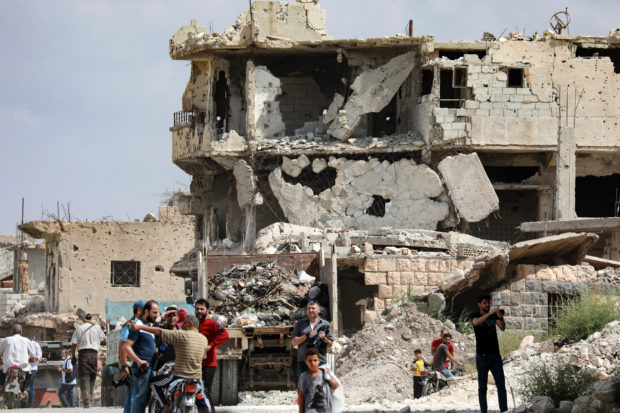Wars involving Russia since the fall of the Soviet Union

A picture taken during a tour organized by the Syrian Ministry of Information shows people gathered in front of a heavily damaged building in the district of Daraa al-Balad of Syria’s southern city of Daraa, on September 12, 2021. AFP FILE PHOTO
PARIS — From Chechnya to Syria, via Ukraine, the Russia of Vladimir Putin has been involved in a string of wars since the fall of the Soviet Union in 1991.
After months of soaring tensions, on Monday Putin ordered his troops to deploy in Ukraine’s self-proclaimed republics of Donetsk and Lugansk, hours after recognizing their independence.
The scope and the calendar for the deployment is still unclear, but the decisions have fueled fears of a major escalation in Ukraine.
Russia has massed more than 150,000 soldiers along Ukraine’s border, according to Washington and Kyiv, and up to 190,000 including separatists.
Here is a recap:
Article continues after this advertisementTwo wars in Chechnya
In late 1994, after tolerating the Caucasus republic’s de-facto independence for three years, Moscow sends in troops to bring Chechnya to heel.
Article continues after this advertisementBut they meet fierce resistance and are withdrawn in 1996.
They are sent back in again in October 1999 under prime minister Vladimir Putin, who will soon be elected president.
Their mission is an “anti-terrorist operation”, in response to deadly attacks in Russia blamed by Moscow on Chechens and an attack by its separatists on neighboring Daghestan.
In February 2000, the Russian army retakes the Chechen capital Grozny, razing it to the ground with artillery and air strikes.
The guerrilla movement continues. In 2009 the Kremlin brings an end to its operation, after two wars in which tens of thousands died on both sides.
Lightning Russia-Georgia war
In August 2008, Russia and Georgia go to war for five days over South Ossetia, a small separatist Georgian region.
In the night of August 7 to 8, the Georgian army launches a deadly offensive to retake control of South Ossetia, of which it had lost control since the crumbling of the Soviet Union and a war in the early 1990s.
Russia immediately riposts, sending its troops into Georgian territory and quickly inflicting a resounding defeat on the ex-Soviet republic.
The lightning conflict claims several hundred lives.
The Kremlin then recognizes the independence of South Ossetia and Abkhazia, another separatist province, and has since maintained a strong military presence there. The West denounces a de-facto occupation.
Conflict in Ukraine
In 2014, after the pro-European Union revolution in Ukraine which forces out the Kremlin-backed leader Viktor Yanukovych, Russia retaliates by annexing the Crimea peninsula.
The annexation is not recognized by the international community.
A separatist uprising then emerges in Donetsk and Lugansk in eastern Ukraine on the border with Russia. They declare independence, unleashing an intense armed conflict with Kyiv.
Kyiv and the West say Russia instigated the eastern uprising and poured arms and troops across the border to bolster them.
Moscow denies the accusations, while acknowledging the presence of Russian “volunteers”.
The conflict has largely abated since 2015 and the signature of the Minsk peace agreements.
But, since late 2021, Russia has stepped up military maneuvers, by air, land and sea, around Ukrainian territory, stationing more than 150,000 soldiers on its border, according to Western estimates.
On Monday, Putin recognizes the independence of the two secessionist republics and orders his troops to deploy there.
The conflict in Ukraine has left more than 14,000 dead since 2014.
Intervention in Syria
Russia deploys its military in war-torn Syria in 2015 in support of the forces of President Bashar al-Assad.
Russia’s intervention, especially with its air power, changes the course of the conflict in Assad’s favor.
It allows the Damascus regime to clock up decisive victories, seizing back territory that had been lost to rebels and jihadists.
Moscow has two military bases in Syria: the aerodrome in Hmeimim in the northwest and the naval port of Tartus, further south.
More than 63,000 Russian military personnel have deployed to Syria, Moscow says.
RELATED STORIES